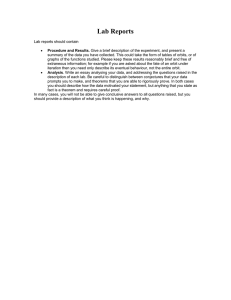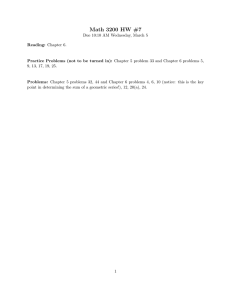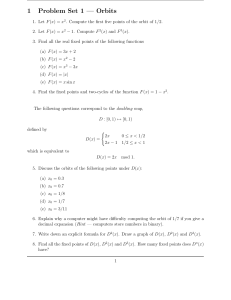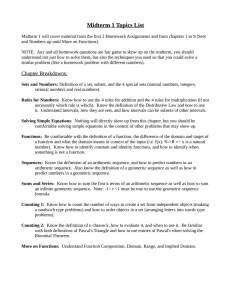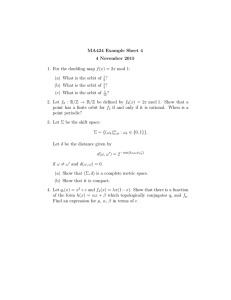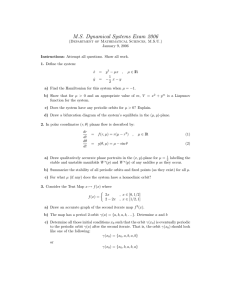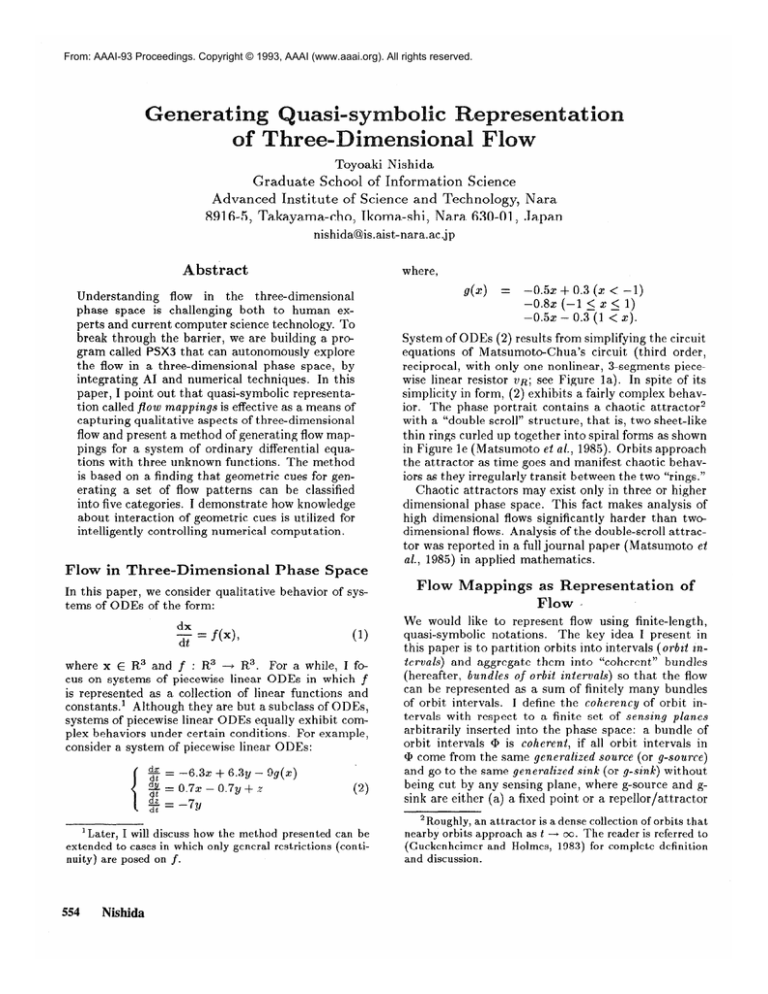
From: AAAI-93 Proceedings. Copyright © 1993, AAAI (www.aaai.org). All rights reserved.
Toyoaki Nishida
Graduate School of Information Science
Advanced Institute of Science and Technology, Nara
8916-5, Takayama-cho, Ikoma-shi, Nara 630-01, Japan
nishida@is.aist-nara.ac.jp
Abstract
where,
Understanding
flow in the three-dimensional
phase space is challenging
both to human experts and current computer science technology. To
break through the barrier, we are building a program called PSX3 that can autonomously
explore
the flow in a three-dimensional
phase space, by
integrating
AI and numerical techniques.
In this
paper, I point out that quasi-symbolic
representation called flow mappings is effective as a means of
capturing qualitative
aspects of three-dimensional
flow and present a method of generating flow mappings for a system of ordinary
differential
equations with three unknown functions.
The method
is based on a finding that geometric cues for generating a set of flow patterns
can be classified
into five categories.
I demonstrate
how knowledge
about interaction
of geometric cues is utilized for
intelligently
controlling numerical computation.
Flow in Three-Dimensional
Phase Space
In this paper, we consider qualitative
tems of ODES of the form:
g
behavior
= f(x),
of sys-
(1)
where x E R3 and f : R3 --) R3. For a while, I focus on systems of piecewise linear ODES in which f
is represented
as a collection of linear functions
and
c0nstants.l
Although they are but a subclass of ODES,
systems of piecewise linear ODES equally exhibit complex behaviors under certain conditions.
For example,
consider a system of piecewise linear ODES:
z
dx
=
-6.3~
$
r
0.;;
+ 6.3~
-
0.7y
-
9g(x)
+ z
(2)
dt1 Later, I will discuss how the method presented
extended to cases in which only general restrictions
nuity) are posed on f.
554
Nishida
can be
(con ti-
s(x)
=
-0.5x
+ 0.3
-0.8x
(-1
-0.5x
-
(x < -1)
5
0.3
x 5
1)
(1 < 2).
System of ODES (2) results from simplifying the circuit
equations
of Matsumoto-Chua’s
circuit (third order,
reciprocal, with only one nonlinear,
3-segments pieceWise
linear resistor VR; see Figure la). In spite of its
simplicity in form, (2) exhibits a fairly complex behavior. The phase portrait
contains a chaotic attractor2
with a “double scroll” structure, that is, two sheet-like
thin rings curled up together into spiral forms as shown
in Figure le (Matsumoto
et al., 1985). Orbits approach
the attractor as time goes and manifest chaotic behaviors as they irregularly transit between the two “rings.”
Chaotic attractors
may exist only in three or higher
dimensional
phase space. This fact makes analysis of
high dimensional
flows significantly
harder than twe
dimensional
flows. Analysis of the double-scroll attractor was reported in a full journal paper (Matsumoto
ei
al., 1985) in applied mathematics.
Flow Mappings
as Representation
Flow r
of
We would like to represent
flow using finite-length,
quasi-symbolic
notations.
The key idea I present in
this paper is to partition orbits into intervals (orbi-t intervals) and aggregate them into “coherent”
bundles
(hereafter,
bundles of orbi indervuls) so that the flow
can be represented
as a sum of finitely many bundles
of orbit intervals.
I define the coherency of orbit intervals with respect to a finite set of sensing planes
arbitrarily
inserted into the phase space: a bundle of
orbit intervals Q is coheren-t,
if all orbit intervals in
Cp come from the same generalized source (or g-source)
and go to the sa,me generalized sink (or g-sink) without
being cut by any sensing plane, where g-source and gsink are either (a) a fixed point or a repeller/attractor
2Roughly, an attractor
is a dense collection of orbits that
nearby orbits approach as t -+ 00. The reader is referred to
(Guckenheimer
and Holmes, 1983) for complete definition
and discussion.
(e)
(a)
the circuit
(b)
characteristic
iR
(c)
=
!?(uR)
mOvR
dvc
i
L%
constants
near
(O,O, 0)
+
;(m,
-
mO)luR
+ BP/
+
+O
-
ml)b’R
-
B,i
equation
C 1 - di = G(w,
Cg%=G(vc,
(d)
of an orbit
of UR
=
the circuit
trace
- vc,)
-g(w,)
-uc,)+iL
= -vc,
and transformation
Cl = l/9,&
= I,L = 1/7,G = 0.7,
= -0.8, B, = 1,
‘UC*= 2, “C, = y,i~ = .z
mo = -0.5,ml
Figure
f:
1: MatsumotoChua’s
g-source
f--T--,
1 \
;..._ \
i
\
\ 1
\.J&rlll-li-;
sensing
plane
circuit
(Matsumoto
et al., 1985) and a trace of an orbit near a double scroll attractor
I, II ___ -1:g-sink
I11’
\
sensing
plane
1
characterized
as:
Figure 2: A bundle of orbi t intervals
tation by a flow mapping
f -+ t
point p26. Orbits in region 0.566(x - 1.5) - 0.775~ $
0.281(~ + 1.05) > 0 approach
the two-dimensional
eigenspace with turning around the eigenspace p26p29.
As they approach the twodimensional
eigenspace, the
spiral becomes bigger and diverges. The flow in R can
be partitioned
into fifteen bundles of orbit intervals.
For example, orbit intervals entering R through region
v105p41p4op10
can be partitioned
into five bundles of
orbit intervals:
and its represen-
@l
1 vlP2P3P4P5
@
@2
1 P2%P43P39P3z3P3QP28P4P3
@
a3
1 P5P4P28P32P31PlO
@
@4
1 p29P3QP31p32P28P30
@
%
: p39p43p41p40
-
with more complex structure, or (b) a singly connected
region of a sensing plane.
A flow mapping represents a bundle of orbit intervals
as a mapping from the g-source to the g-sink. Thus,
it is mostly symbolic.
However, it is not completely
symbolic as we represent the shape of g-sources and gsinks approximately.
Figure 2 schematically
illustrates
a bundle of orbit intervals and its representation
by
a flow mapping,
where the g-sinks and g-sources are
connected regions of a sensing plane. We are interested
in minimal partition
of flow into coherent bundles of
orbit intervals that would lead to minimal description
length.
Figure 3 shows minimal
partition
of the flow of
Ma,tsumoto-Chua
equation (2) in a three-dimensional
region R : 1 5 x < 3,-2
2 y 2 2,-3
< z 5
3,0.566(x-1.5)-0.775y+O.281(2+1.05)
2 0 into bundles of orbit intervals.
Plane 0.566(x - 1.5) - 0.775~ +
eigenspace and
0.281(z+1.05)
= 0 is a two-dimensional
line p26p29 is a one-dimensional
eigenspace of a fixed
-
~lPlP8P6P5
plpSlp35p36p34pZSp22p9p8
Generating
Three-
-
-
PllP15P38P3OP31PlO
-
P25p23P24p23P34p33
P44P43p41p42.
Flsw Mappings for
imensional
lOW
In order to design an algorithm of generating flow mappings for a given flow, I have studied the relationships
between geometric patterns that flow makes on the surface of sensing planes and the topological structure
of
underlying
orbit intervals, and found that they can be
classified into five categories called geomeiric cue interuction patterns. My algorithm
makes use of geometric
cue interaction
patterns
as local constraints
both to
focus numerical analysis and interpret the result.
Geometric Cues
Let us consider characterizing
flow in a convex region
called a cell which is bounded by sensing planes by a
set of flow mappings.
In order to do that we study
Qualitative Reasoning
555
iu3
I
‘2
IS
,(:
i
..
/
:’
0
32
z
-2
r-----
7
P40
Figure 3: Anatomy of flow of Matsumoto-Chua
3,0.566(x - 1.5) - 0.7759 + 0.281(2 + 1.05) 2 0
556
Nishida
equation
(2) in Region
R : 1 _< x < 3,-2
< y 5 2,-3
< z 5
geometry that orbits make on the surface of a sensing
plane.
I classify the surface in terms of the orientation
of
orbit there.
A contingent
section S of the surface is
called an entrance section if S is on a single sensing
plane and orbits enter the cell at all points of S except some places where the orbits are tangent to the
surface.
An ezi-t section is defined similarly.
An entrance or exit section (e.g., exit section vlp5p72~q) may
be further divided into smaller sections (e.g., sections
ww4,
~1~5p6~~3~1,
and p6p7p8)
by one or more section
boundary (e.g., vlpl and psps), which may be either (a)
an intersection
of sensing planes, (b) an image or an
inverse image of a section boundary,
or (c) an intersection of a two-dimensional
eigenspace
and the cell
surface. Section boundaries
play an important
role as
primary geometric cues on the surface.
Tangent sections separate entrance and exit sections.
Tangent sections are further classified into two categories: a concave section (e.g., ~5~7) at which orbits
come from the inside the cell, touch the surface, and
go back to the cell, and a conzlex section (e.g., vlp5 and
plop31) at which orbits come from the outside the cell,
touch the surface, and leave the cell.
An intersection
of an eigenspace and the surface3 is
called a pole or a ground depending
on whether the
eigenspace is one-dimensional
or two-dimensional,
respectively.
In Figure 3, point p29 is a pole and line
segments ~41~40, ~40~18, mm,
etc are grounds.
A lhorn is a one-dimensional
geometric object which
thrusts outward from section boundary
into an entrance/exit
section. In Figure 3, there are two thorns:
of
p23p24
and p3oP29 - Thorns result from peculiarity
eigenspace.
Interaction
of geometric cues may result in a junction of various types. For example, section boundaries
~2~4
and ~5~14~28 in Figure 3 meet, at ~4, making a Tjunction, while vlplpsl and v4p1p8 make an X-junction
at PI.
SOme
geometric
cues such as fixed point p26 or convex section plop31 are triviaE in the sense that they
can be easily recognized by local computation
without
tracking orbits, while others such as a T-junction
at
p4 are nontrivial
because they cannot be found without predicting their existence and validation by focused
numerical analysis.
Geometric
Cue Interaction
Patterns
I have classified interactions
of geometric cues into five
categories, as shown in Figure 4. Each pattern is characterized by a landmark orbit such as X1X2 in an X-X
interaction
or TlX in a T-X interaction
that connect
geometric cues.
A X-X (“double X”) interaction
is an interaction
3For simplicity, I assume that no surface of a cell is an
which is a special subspace consisting of orbits
tending to/from a saddle node.
eigenspace,
between boundary sections. In Figure 3, example of a
X-X interaction
is with the landmark orbit ~2~1.
A T-X and a T-T (“double T”) interaction
co-occurs
with a concave section, which “pushes in” or “pops
out” bundle of orbit intervals. In Figure 3, example of
a T-X int,eractions is with landmark orbit ~28~22~38.
A Pole-T interaction
results from peculiarity
of orbits in an eigenspace
of a saddle node.
The closer
the start (or end) point of an orbit approaches
the
ground, the closer the end (or start) point of an orbit
approaches the pole. Special care is needed for searching for a Pole-T interaction
when the derivative of the
flow at the fixed point has complex eigenvalues,
for
a boundary
edge may turn around the pole infinitely
many times.
A Thorn-T interaction
accompanies peculiarity,
too.
A T-junction
consisting of a section boundary, a convex
section, and a concave section is mapped to/from the
top of a thorn. Points on the section boundary
of the
T-junction
are mapped to/from the concave section,
points on which are in turn mapped to/from the body
of the thorn.
Analysis
Procedure
Roughly, a procedure for generating flow mappings for
a given cell consists of four stages: (stage 1) recognition of trivial geometric cues, (stage 2) recognition
of
nontrivial
geometric cues, (stage 3) partitioning
of the
cell surface into coherent regions, and (stage 4) generation of flow mappings.
Instead of describing the procedure in detail,4 I will
illustrate
how it works for the top-left portion of the
cell shown in Figure 3. As a result of the initial analysis, the surface is classified with respect to the orientation of flow and trivial geometric cues are recognized
as shown in Figure 5a.
Then, orbits are numerically
tra,cked from sampling
points on each trivial geometric cue. When the images
or/and inverse images are obtained, they are examined
to see whether they suggest the existence of a nontrivial geometric cue. For the case in hand, as pis move
downward from vertex VI, their images $~(pi)s jump
from the top plane to the rear plane, suggesting
the
existence of an X junction
(Figure 5b). Similarly, as
qjs go to the right, their inverse images +-l(qj) jump
from the left plane to the front plane, suggesting
the
existence of another X junction
(Figure 5~).
Explanation
is sought that may correlate the two X
junctions,
by consulting
a library of geometric cue interaction
patterns.
As a result, a X-X interaction
is
chosen as the most plausible interpretation.
The approximate location of the landmark orbit is computed
by focused numerical computation
(Figure 5d).
The algorithm
is implemented
as PSX3 (Nishida,
1993)) except procedures for Pole-T and Thorn-T interactions.
We have tested the current version of PSX3
41nterested reader is referred to (Nishida, 1993) for more
detail.
Qualitative Reasoning
557
Figure
against a few systems
flow does not contain
Generalization
4: Geometric
of piecewise linear ODES whose
Pole-T or Thorn-T interactions.
to Nonlinear
5 Degenerate flows are rare, even though generative property (Hirsch and Smale, 1974) (a proposition that the probability of observing a degenerate flow is zero) does not hold
for three-dimensional
flow.
61t should be noted that a nonlinear simultaneous
equation solver may not always produce
a complete
answer.
Dealing with incompleteness
of numerical computation
is
Some early results are reported
open for future research.
in (Nishida et al., 1991).
Nishida
Patterns
Implementation
ture.
of these codes is, however,
left for fu-
ODES
So far, I have carefully limited our attention
to systerns of piecewise linear ODES, for which the flow in
each cell is linear. However, it is not hard to extend
the method to nonlinear
ODES, if we are to handle
only non-degenerate
(i.e., hyperbolic) flow~.~ What to
be added is twofold: (a) a routine which will divide the
phase space into cells that contain at most one fixed
point, and (b) a g eneral nonlinear (non-differential)
simultaneous
equation solver. Neither of these are very
different from those that have been implemented
for
analyzing two-dimensional
flow (Nishida and Doshita,
1991)?
Another thing we might have to take into account
is the fact that certain assumptions
such as planarity
of an eigenspace do not hold any more. Fortunately,
local characteristic
of a nonlinear flow is equivalent to
a linear flow, as linear approximation
by Jacobian preserves local characteristics
of nonlinear
flow as far as
the flow is hyperbolic.
Thus, the local techniques work.
Globally, we have not made any assumption
that takes
advantage of the linearity of local flow, so it also works.
558
Cue Interaction
This work ca*n be thought of as development
of a basic
technology for intelligent scientific computation
(Abelson et al., 1989; Kant et a/., 1992), whose purpose is
to automate scientific and engineering problem solving.
In this paper, I have concentrated
on deriving quasisymbolic, qualitative
representation
of ODES by intelligently controlling
numerical analysis. Previous work
POINCARE (Sacks, 1991),
in this direction involves:
PSX2NL (Nishida and Doshita,
1991), Kalagnanam’s
system (Kalagnanam,
1991), and MAPS (Zhao, 1991).
KAM (Yip, 1991) is one of the frontier work, though
it is for discrete systems (difference equations).
Unfortunately,
these systems are severely limited to twodimensional
flows, except MAPS.
Zhao claims MAPS (Zhao, 1991) can analyze ndimensional
flows too. MAPS uses polyhedral
approximation of collection of orbits as intermediate
internal representation.
As polyhedral
approximation
represents rather the shape of flow than the topology,
it is not suitable for reasoning
about qualitative
aspects in which the topology of the flow is a main issue.
The more precise’ polyhedral
approximation
becomes,
the more irrelevant information
is contained, making it
harder to derive topological information.
In contrast,
flow mappings
only refer to g-sinks and g-sources of
bundles of orbit intervals, neglecting the shape of orbit intervals in between.
As a result, (a) topological
information
is directly accessible, and (b) unnecessary
computation
and memory are suppressed significantly.
(a) classify
(b)
the surface
tracking
the orbits forward
at p, (i = 1,2,.
esit section
convex
section
e-ntrance
section
v
-%
convex
section
-3
\
section boundaq
(exit)
&
convex section
(c) tracking
(d) interpretation
the orbits backward
at q, (i = 1,2,.
.)
geometric
.)
based on
cue interaction
patterns
/
‘0
ti
Figure
Limitations
The method
itations.
reported
5: A process
of generating
of the A
Hirsch,
in this paper has two major
First, it is not straightforward
lim-
to extend it to
general n-dimensional
flow, even though the underlying concepts are general, for I have chosen to improve
efficiency by taking advantages
of three-dimensional
flow. Second, the current approach may be too rigid
with respect to t,he topology of flow. Sometimes,
we
may have to pay a big cost for complete information,
especially when the topology of the flow is inherently
complex (e.g., fractal basin boundary
(Moon, 1987)).’
Making the boundary fuzzy might be useful.
Concausion
Automating
trolled
qualitative
numerical
analysis
analysis
by intelligently
involves
reasoning
conabout
complex geometry and topology under incomplete
information.
In this paper, I have pointed out that complex geometric patterns of solution curves of systems of
ODES can be decomposed into a combination
of simple geometric patterns called geometric cue interaction
patterns, and shown how they can be utilized in qualit ative analysis of three-dimensional
flow.
References
Abelson,
Harold;
Eisenberg,
Michael;
Halfant,
Matthew;
Katzenelson,
Jacob; Sacks, Elisha; Sussman, Gerald J.; Wisdom, Jack; and Yip, Kenneth
1989. Intelligence in scientific computing.
cations of the A CM 32:546-562.
Guckenheimer,
John
and Holmes,
flow mappings
Philip
linear Oscillations, Dynamical Systems,
tions of Vector Fields. Springer-Verlag.
Commun,i-
1983. Nonand Bifurca-
7Note that this d oes not mean the current approach is
not suitable for analyzing chaos. Remember that the example I have used in this paper is Matsumoto-Chua’s doublescroll attractor which is known as a chaotic attractor.
Morris
ferential
Algebra.
for (2)
W. and Smale,
Equations,
Dynamical
Stephen
Systems,
Difand Linear
1974.
Academic Press.
Kalagnanam,
J ayant 1991. Integration
of symbolic
and numeric methods for qualitative
reasoning. Technical Report CMU-EPP-1991-01-01,
Engineering
and
Public Policy, CMU.
Kant, Elaine; Keller, Richard; and Steinberg, Stanly,
Working Notes Intelligent
Scientijc
editors 1992.
Computation.
telligence.
American
Association
AAAT Fall Symposium
for Artificial
In-
Series.
Matsumoto,
Takashi; Chua, Leon 0.; and Komuro,
Motomasa
1985. The double scroll. IEEE Trunsactions on Ciruits and Systems CAS-32(8):798-818.
C. 1987. Chaotic
for Applied Scientists
Moon, Francis
troduction
Vibrutions - An Inand Engineers.
John
Wiley & Sons.
Nishida., Toyoaki and Doshita, Shuji 1991. A geometric approach to total envisioning.
In Proceedings
IJCAI-91.
1150-l 155.
Nishida,
Toyoa,ki; Mizutani,
Kenji; Kubota,
Atsushi;
and Doshita, Shuji 1991. Automated
phase portrait
analysis by integrating
qualitative
and quantitative
analysis. In Proceedings AAAI-91.
811-816.
Nishida, Toyoaki 1993. Automating
qualitative
analysis of three-dimensional
flow. (unpublished
research
note, in preparation).
Sacks, Elisha P. 1991. Automatic
analysis of oneparameter
planar ordinary
differential
equations
by
intelligent
numeric simulation.
Artificial Intelligence
48:27-56.
Yip, Kenneth
plex dynamics
Man-kam
1991. Understanding
comby visual and symbolic reasoning.
Ar-
tificial Intelligence
51( l-3): 179-222.
Zhao, Feng 1991. Extracting
and representing
qualitative behaviors of complex systems in phase spaces.
In Proceedings IJCAI-91.
1144-l 149.
ualitative Reasoning
559

